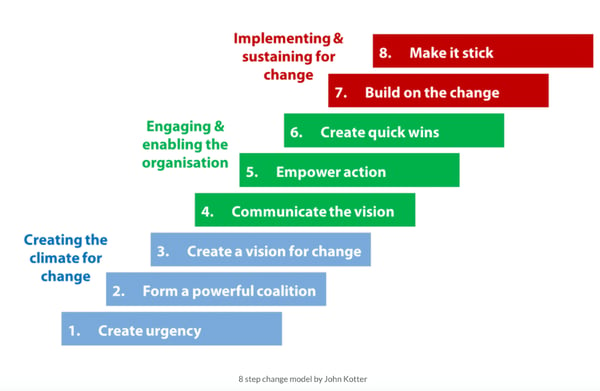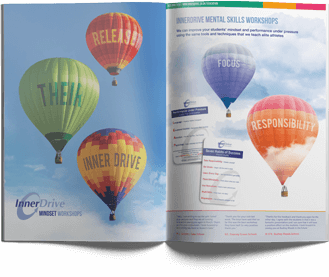What is the psychology behind helping a group of people make a positive behaviour change?
Good intentions may often fall short and an initial spark of change often fails to stay alight. Both for the people needing change and for the people helping them to do so, a structure to apply can come in handy.
In recent years, a number of theories have been developed which look to give people and organisations strategies that they can use to successfully help others commit to positive change. One particular model that appears to have stood the test of time is Kotter’s 8 Step Model of Change.
So, how does this model suggest organisations can bring about change?
Kotter’s 8 Step Model of Change

Kotter suggests that change can successfully occur if an individual or organisation follows eight different steps. These steps can be divided into three broader categories which are:
- Creating the climate for change
- Engaging and enabling
- Implementing and sustaining for change.
Creating a Climate for Change
Create urgency
Change only properly occurs when there is a sense of urgency, such that everyone involved is fully invested in making something happen.
Simply pointing out the problem is often not enough to facilitate this urgency. Instead, make sure to have open conversations with people from across the group. Through examining previous threats and future opportunities, these can demonstrate why change is necessary.
Form a powerful coalition
This step of Kotter’s Model of Change entails bringing together a group of people who are guaranteed to work well together, will demonstrate passion and will work tirelessly. Whilst this will initially bring about a sense of urgency, it will eventually bring change.
This group needs to include a range of influential people that offer different types of expertise and experiences of working within numerous levels of the company. By recruiting a wide range of people, every employee can feel represented and included in the process, hence reducing the likelihood of any later resistance to change.
Create a vision for change
Often, when the word “change” is mentioned, everyone within an organisation wants to have their say.
This leads to people putting forward hundreds of suggestions, and hence confusion. Therefore, it is important for the Model of Change to work that ideas are collated into one single, clear vision that all employees are aware and recognise the importance of.
This overall vision should be broken down into a number of smaller steps that the company wants to achieve. The creation of a step by step plan can help others better understand the process, and it will allow easier tracking of the progress made.
Engaging and Enabling the Organisation
Communicate the vision
In order to implement the vision for change successfully, the plan’s leaders must ensure that they communicate it well. This is an important part of getting other employees on their side and the only way to make sure the change they want actually happens.
In order to communicate the vision well, leaders should present information only if it is relevant and will assist employees in understanding how the changes will improve their experiences at work. Leaders also need to ensure that they are open and honest, meaning that they are willing to consider others’ points of view and address any concerns.
Finally, it is all well and good communicating a vision to others, but it is useless if it isn’t followed by actions in the plan’s direction. Therefore, it is imperative to the success of the Kotter’s model of change that those in charge demonstrate the desired behaviours.
Empower action by removing barriers
For change to be as effective as possible, all employees need to understand and believe in it.
Therefore, it is important to identify those resisting change and have discussions with them surrounding the issues they want to address and how they can be resolved.
On the other hand, those who are actively endorsing change and helping with the process should be rewarded, with the hope that this will encourage others to engage too.
Create quick wins
Unfortunately, change does not happen overnight. It may take months or even years for an organisation to reach their overall goal.
Being faced with such a long wait and process can quickly become a source of demotivation for employees and push them to give up on the vision.
Therefore, it is important that the overall goal is split into smaller goals that the group can achieve quickly. This allows employees to track progress more easily – and to find motivation in the success associated with reaching these smaller goals.
Being able to demonstrate to employees that progress is being made is also important in reducing the number of critics and negative thoughts surrounding the process.
Implementing and sustaining for change
Build on the change
Just as an organisation never stands still, neither should the changes they implement.
Once the overall vision that pushed them to implement Kotter’s model of change has been achieved, it is important that the organisation analyses and reviews each step they took to get there.
This not only allows for the identification of what went well but also what future improvements the organisation can make.
Make it stick
For a change to stick, it needs to be embedded into the culture of the organisation on all levels. There are many ways to maintain change, such as:
- Reinforcing the new culture through training
- Sharing success stories to inspire others
- Ensuring all new employees hired fit the culture that has been created
Final Thoughts
Organisations often underestimate the difficulty of fully and successfully implementing change – and the effort it requires.
However, a change to organisational culture becomes much more achievable if an organisation applies Kotter’s 8-step model of change by:
- Demonstrating to its employees the importance of change;
- Creating short term goals to assist the pursuit of a long-term vision;
- Continuing to promote change through training and careful recruitment of new employees.






